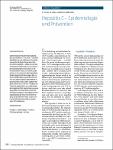Hepatitis C
Epidemiologie und Prävention
Schreier, Eckart
Höhne, Marina
Epidemiologische Studien haben gezeigt, dass das Hepatitis-C-Virus (HCV) – vor seiner Identifizierung und molekularen Charakterisierung der häufigste Erreger einer Posttransfusionshepatitis – weltweit verbreitet ist. Die rasche EinfüFhrung von HCV-Antikörpernachweissystemen bzw. des HCV-Genomnachweises führte zur Aufklärung der als Non-A, Non-B bezeichneten Hepatitiden. Epidemiologische Studien zeigen, dass ca. 3% der Weltbevölkerung mit dem HCV infiziert sind, dabei existieren beträchtliche regionale Unterschiede. Zudem ergeben sich große Differenzen in der HCV-Prävalenz des Untersuchungsklientels. Aus molekularepidemiologischer Sicht zeigt sich eine gewisse geografische Dominanz bestimmter HCV-Genotypen/Subtypen. Hinsichtlich der Übertragungswege gilt heute nur die Übertragung auf parenteralem Wege als gesichert. Unklar bleibt der hohe Anteil an sporadischen HCV-Infektionen. Epidemiological studies have demonstrated a world-wide distribution of hepatitis C virus (HCV), which before its identification and molecular characterization has been the most frequent infectious agent causing post-transfusion hepatitis. The rapid establishment of HCV antibody detection systems and HCV genome detection assays resulted in the clearing up of those hepatitis cases which had been designated as Non-A, Non-B. According to epidemiological studies, around 3% of the world population are infected with HCV, with considerable regional differences. HCV prevalence also varies widely depending on the cohort investigated. From a molecular epidemiological point of view a geographical dominance of certain HCV genotypes/subtypes is observed. Regarding routes of transmission, only parenteral transmission is established beyond doubt. However, the cause of a high number of sporadic HCV infections remains obscure.
Dateien zu dieser Publikation
Keine Lizenzangabe

